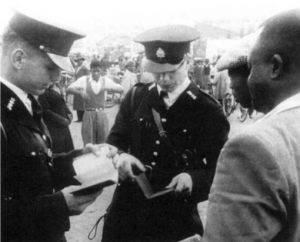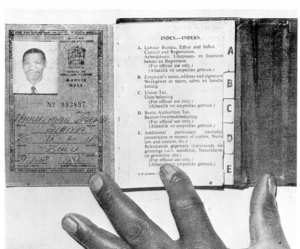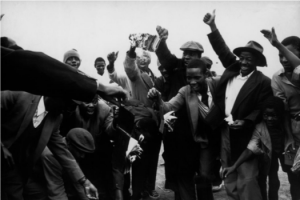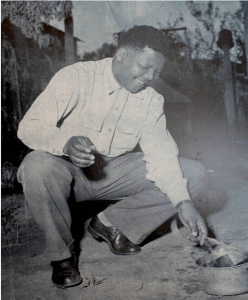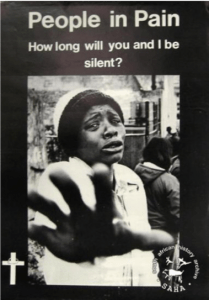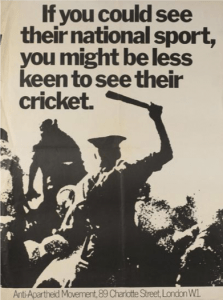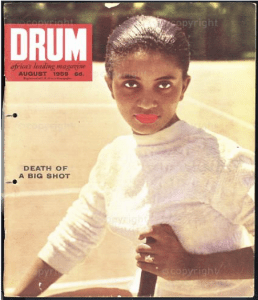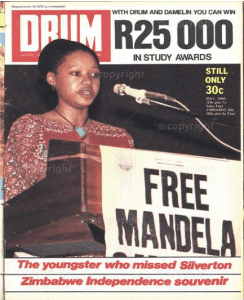In the struggle against Apartheid in South Africa, authors like Marietta Kesting have shown, documentary-style images were used as weapons against the oppressive government to attack the injustices of the system. Gil Hochberg has written that ‘visual politics’ are embedded in the relationship between vision, power, domination and control as well as in visual arrangements created by the oppressor in an oppressive regime. As such, during Apartheid in South Africa, visual arrangements informed what was seen, how they were seen, and in what ways/circumstances they could be seen. Therefore, to understand how oppressive regimes unravel implies understanding the disruption of such a regime’s visual arrangements.
Apartheid South Africa, one of the most notable examples of institutionalized racial segregation, serves as a useful case study to examine the impact of images, using the lens of visual politics. This means analysing the iconic images of the Anti-Apartheid Movement (‘AAM’ or ‘the Struggle’), within the framework of the visual arrangements that existed in South Africa, in order to highlight the disruptive effect images can have in an oppressive system.
THE VISUAL ARRANGEMENTS OF APARTHEID SOUTH AFRICA
From Jim Crow segregation in the American South to Nazi Germany, and (in this context) Apartheid South Africa, a common thread across these regimes was control of the public sphere of visibility. For example, racial segregation in the Jim Crow South and South Africa involved separating public and residential spaces between the races, and clearly marking these spaces with ‘Whites Only’ or ‘Coloured Only’ signs. According to Marietta Kesting, the Apartheid government also adopted other means of controlling visibility such as banning ‘shocking’ images that could incite the black majority, and by restricting positive images, such as those of Nelson Mandela who was incarcerated in Robben Island. This ban largely involved the restriction of photography i.e. who could take photographs, what kind, and when.
South Africa’s Publications Act of 1972, made available online by Padraig O’Malley, gave specially created government agencies the power to decide whether certain publications were ‘desirable’, and criminalized the production, distribution or even possession of works declared undesirable. The control of the creation and dissemination of images essentially meant a control of a range of possible reactions to images, illustrating the affective potential of images. Notions of visual rights, what Hochberg describes as the ‘right to be seen, look, or take your own image’ thus also come to mind. As much as individuals have the right to be invisible, they also have a right to be seen, and one could argue that visual arrangements in which a group of people are made invisible, can be disrupted by the circulation of images of those same people who have been concealed.
Analysing the role of images in the struggle against Apartheid requires centring the affective and disruptive nature of images of black suffering in particular, and how exactly such images interfered with the visual arrangements that were part of the status quo in Apartheid-era South Africa. One of the major visual arrangements in Apartheid-era South Africa was the erasure of black people from the cities, and the creation of all white areas and ‘white spaces’ thus ‘splitting the visual field’, ensuring that non-whites lived in townships, and used different spaces in their daily lives. Integral to this system was the implementation of Pass Laws, which essentially restricted movement for the black population, limited their access to work in the cities, and criminalized the majority of the black population in South Africa. This fixed them in a state of what Ariella Azoulay describes as ‘flawed citizen(ship)’.
An interesting parallel that can be drawn to this would be the existing visual arrangements in the Israeli-Palestinian conflict, where the Israeli government has been investing heavily into making the ‘militarized formation’ of its society as invisible as possible—even as Israel is, arguably, a highly militarized society. This exercise has involved, for instance, the beautification of the Separation Wall on the Israeli side with graffiti and beautiful paintings, and the planting of forests over Palestinian ruins. It also reveals a systemic concealment of the unjust reality of the plight of the Palestinians.
Palestinians naturally highlight images of violent conflict to make the conditions of living under military occupation visible. At the same time, authors like Hochberg have explained how Palestinians live under constant surveillance, engaging with visual reminders of Israeli dominance everyday such as the Separation Wall and the checkpoints. In this image of an Israeli checkpoint, the bars of the checkpoint bring to mind prison bars, and the restriction of freedom. Such constant visual reminders of the dominance of the ‘other’ again places citizens (in this case Palestinians) in a state of ‘flawed citizenship’. In South Africa, visual reminders also included constant policing, and being checked for passes. In the image below, uniformed white policemen check the passes of black men in suits, with one of the black men gazing at the policemen’s’ hands holding the passes and the other staring at the face of the policemen, evoking a sense of tense impatience. The police are obstructing not only their movement, but also their time and agency.
There is, however, a widespread lack of visual evidence of the extent of the brutality and mass incarnation that occurred in Apartheid South Africa as a result of Pass Laws—again due to the institutionalized restriction of photography and press. It could be argued that the passes themselves, and the photographs of the passes, now serve as evidence. As the Pass Laws became increasingly sophisticated, passport-style photographs became a part of each person’s passbook. This portrait style photograph situated normally in the top right corner of the first page, would link the individual to their legal identity. Azoulay helps us understand that the passbook signifies the relationship between the individual and the government i.e. their citizenship, as well as the nature of this citizenship, which exists in an oppressive context. Thus, the next image, the passbook in which an identity photograph is juxtaposed with an official South African stamp of the coat of arms, signifies a loss of agency. It represents an identity given to an individual by his oppressor. It could be said that both the image and the passport photograph within the image, serve as a testament to this oppressive relationship, as a result of what Leigh Raiford has called the ‘irrefutable nature of photographs’. It is, thus, the irrefutability of these photographs that allows them to exist as evidence of an occurrence.
DISRUPTING VISUAL ARRANGEMENTS
Gil Hochberg has argued that the generation of ‘new ways of seeing’ is essential to overcoming geo-political orders, by reworking the dominant visual fields. Pass Burning demonstrations and the images that emerged from these demonstrations are an example of a visual disruption of the ‘sanitized’ image that the Apartheid government was trying to create. According to photo-historian, Okwui Enwezor, ‘no form of testimony frightened the [Apartheid] regime more than photography did, with its powerful testimony that could be used to expose and counteract the sanitized, propagandistic images working in the government’s favour’. In the next image, protesters burn their passes, with excitement. Their raised hands, thumbs-up signs and smiles evoke a sense of exhilaration and freedom, signifying the disruption of an oppressive configuration. The image bears much similarity to the ‘Black Power’ fist commonly associated with both the American Civil Rights Movement, and the Struggle.
One of the most significant pass burning protests resulted in brutal violence from the South African police in Sharpeville, 1960. About 69 people were killed and 300 injured, followed by denials by the police, who claimed the police were attacked by the protesters. The only photographer who was present, photojournalist Ian Berry, took pictures of the violent repression that ensued (see Image 5.0.). These photographs ended up serving as evidence years later in court about the true nature of the repression in March 1960 and helped prove the victims’ innocence. In Leigh Raiford’s 2006 analysis of Ida B. Wells’ use of lynching photographs as evidence in anti-lynching campaigns, she argues that the using the photographs the way Wells did made the reality and sureness of the lynchings ‘proven’. A parallel can be drawn here, given that the attempts by the South African police force to frame the Sharpeville Massacre differently, were eventually countered by the presence and, according to Hochberg, ‘witness’ of the photographs taken by Ian Berry.
Nelson Mandela responded to the Sharpeville violence by burning his own passbook a week later, in front of dozens of spectators and reporters, a dramatic political statement from his party the African National Congress. The destruction of the pass, an official document, represented severance of the link between the South African government and Mandela, and his reclamation of identity and agency. The fact that he burnt his passbook before dozens of spectators and photographers, makes this iconic photograph (and the few others that were released), a direct message from Mandela and the ANC to the regime. His face in this photograph is serene and confident as he squats to burn his pass. It portrays a defiance, a snatching back of dignity, and what Raiford would call a ‘reframing’—a reframing of the entire Sharpeville incident, one could argue. According to Raiford, the ANC were ‘intervening in their racial making and undoing the racial making of their (oppressor)’. One could also argue that the ANC were, to use Hochberg’s language, ‘redirecting the gaze’ of the dominant other.
Another iconic image from the Apartheid struggle emerged from the Soweto Uprisings of 16 June 1976, which was yet again a case of violent repression by the South African police. In this case, the repression was of a group of schoolchildren who gathered to protest Afrikaans as the official language of instruction in local schools. The photograph depicts the dying Hector Pieterson at age 13, being carried by another Soweto resident (Mbuyisa), with his older sister (Antoinette) running next to them. It’s a frozen moment that also conveys motion as the two youths are running. Hector’s missing shoe, and blood on the side of his mouth vividly illustrate the chaos and danger surrounding them from the shooting by the police. Pain, fear and anguish are on both Antoinette and Mbuyisa’s faces. It is a photograph of a dying child. In her 2017 book, Affective Images: Post-apartheid Documentary Perspectives, Marietta Kesting refers to this photograph as having an ‘affective excess’ and argues that this is one of the main reasons it became a visual icon of the anti-Apartheid movement. For her, the affective image translated into affect, and then into political action. Furthermore, Kesting notes that ‘it is painful to look at, and it constitutes an open wound’, standing out as a symbol of the brutalities of the Apartheid government.
As the Apartheid struggle progressed, more and more images of violence came to be used strategically by activist organizations. Such images eventually became the centre of many posters—to display the injustice, and, according to Kesting, to trigger outrage as a means of mobilization. A poster entitled ‘People in Pain’ was produced at the height of the anti-Apartheid movement, by the Student Union for Christian Action, established in 1979. The poster uses an image of a woman crying out in protest during a forced removal in the early 1980s. These forced removals were part of the systemic creation of white spaces, implemented by legislation that segregated the country into racially constructed group areas. The caption ‘people in pain: how long will you and I be silent?’ in white text on a black background frames the image.
Susan Sontag’s argument that ‘all photographs wait to be explained or falsified by their captions’ is especially relevant here. The poster’s caption, the question, ‘how long will you be silent?’ is an insistence, and an appeal to morality, questioning the viewer about what he or she intends to do about the pain and distress faced by the subject. The caption adds an urgency to the image, while the contrasting white text on black background contributes to this urgency.
Similarly, a poster from a campaign by the British Anti-Apartheid Movement in 1970, is another example of a strategic use of images. According to Sergio Seçanha, Alan Mclean and Larry Buchanan, with this campaign, the British Apartheid Movement forced the cancellation of the all-white South African cricket team’s visit to Britain, in one of the more prominent victories of the anti-Apartheid movement. The image used in the poster is reminiscent of the many violent repressions that occurred in response to protests during Apartheid, such as Sharpeville and the Soweto Uprisings. The image depicts a policeman about to hit at a person he seems to be restricting. The figures in the image are quite abstract, however the caption once again has the effect of explaining, whilst creating shock: ‘if you could see their national sport, you might be less keen to see their cricket’. This frames the violence of the police officer as a sport, for enjoyment. The British government ended up instructing the Cricket Council to withdraw their invitation to South Africa—yet another disruption of the visual arrangements of Apartheid South Africa.
COUNTERING DEROGATORY IMAGES
‘Visual economy’ is the term Christopher Pinney uses to describe what he calls the ‘extraordinary circumstances of inequality that give rise to the vast majority of (stereotypical) images inhabiting the colonial archives’. The colonial archive in the case of South Africa, is made up of these images of black pain and suffering that have so far been examined, thus bringing to mind the idea of the ‘representation’ of black bodies. Leigh Raiford, however, refers to ‘multiple archives vying for prominence’ and being used to represent the race. Under Jim Crow in the American South for example, Raiford argues in the essay, ‘On Lynching, Visuality and the Un/Making of Blackness’, that African Americans sought to ‘unmake the identities created for them’ in all the cruel photographic portrayals, by countering these images with their own ‘carefully cultivated self-images’. There was a similar unmaking in South Africa, and Drum Magazine is an epitome of this.
Drum Magazine, which was established in 1951, portrayed black South African lives under Apartheid. According to Marietta Kesting, the magazine reported black culture and life in the townships, thus creating new representations of blackness whilst offering intellectual discussion. Many of the cover images during Apartheid depicted glamour, as seen with the cover of the model the next set of images, love, happiness and affluence, which can be said to also have the effect of ‘reframing’ the cruelties experienced by black South Africans. Today, such images act as a competing archive of black representation in South Africa.
The images from Drum Magazine can also be categorized as another form of disruption of the visual arrangements during the Apartheid regime, which sought to keep the black South African population subdued, subservient and out of sight. It was, once again, a snatching back of identity and a method of ‘generating new ways of seeing’ which as Gil Hochberg argues, has the effect of disrupting geo-political orders. Furthermore, it was a process of simultaneously making black South Africans visible in a society that sought to make them invisible (and, therefore, fixed in a state of flawed citizenship). This process of generating new ways of seeing ‘blackness’ in Apartheid South Africa, was thus imperative in the process of establishing the non-white South African as a full, rightful citizen of the country.
As the anti-Apartheid movement progressed, Drum Magazine became increasingly politicized. The Drum Magazine cover from May 1980, shows Zinzi Mandela at a ‘free Mandela’ campaign. The ‘Free Mandela’ words draped on the podium frame this image, causing it to evoke a sense of revolution, and is a reassertion of agency from the black population. Retrospectively, it is also symbolic of the freedom we now know was to come for Mandela and the black South African population in about a decade from this 1980 issue. Though, in ‘On Lynching…’, Raiford argues that these competing archives contradict each other to highlight the ‘constraints of visual representation as a strategy for liberation’, it could be argued that the archives actually complement each other—especially when one considers what Christopher Pinney calls the inherent ‘volatility of the image’, its guarantee of ‘multiple surfaces’ and the possibility of ‘looking past’. The seeming contradiction tells the whole story, with all the different archival narratives of hardship, pain, suffering, constraint, action, agency, struggle, resilience and strength feeding into one another to paint the full picture.
VISUAL DISRUPTION AND ANTI-APARTHEID IMAGERY
From the iconic images of the anti-Apartheid movement, given the visual arrangements established by the South African government at the time, it can be said that the role of images during the anti-Apartheid movement was one of disruption. Affective images like that of Hector Peterson or the Sharpeville Massacre stimulated political action or exoneration; images of Pass Burning ‘redirected the gaze’; the strategic use of images in posters for campaigns domestically and abroad enabled concrete political result, and the use of positive images such as on the covers of Drum Magazine unmade the black identity being created by the regime and inspired hope. From the beginning, the South African government systematically attempted to suppress these results through its oppressive laws and policies of concealment, but this was unsustainable, given the resilience of those that were oppressed. All the different actors that made up the anti-Apartheid movement ultimately succeeded in being seen, challenging the ways in which they were seen, and eventually, disrupting the institutional forces that held the Apartheid regime together⎈



